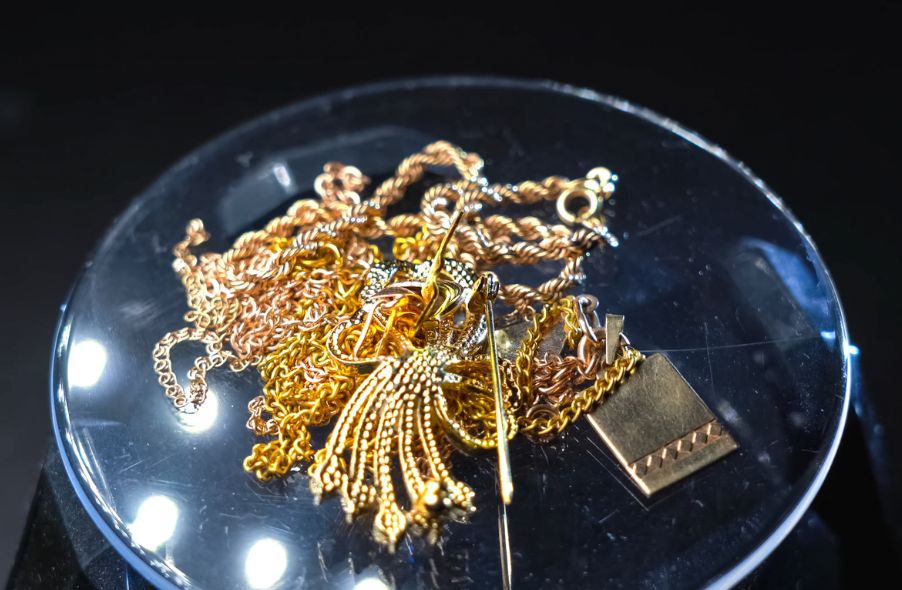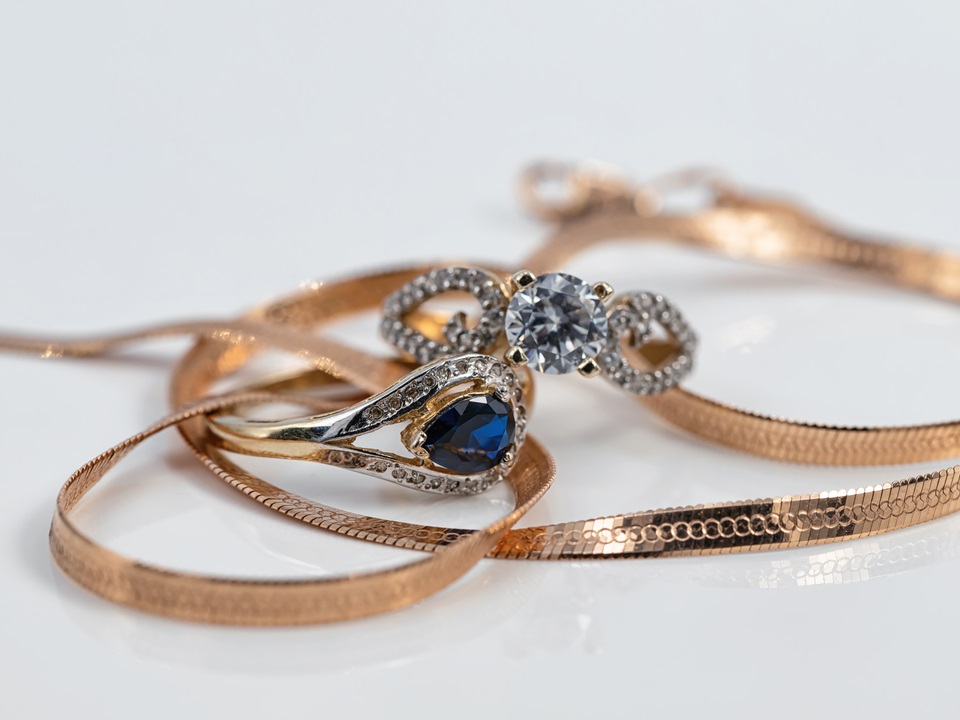Imagine walking into a local jeweler’s shop when a stunning gold necklace catches your eye. How can you be sure the object is actually made of gold or only appears that way to get more money on the sale? Most trustworthy retailers incorporate real gold into their products, but the way it’s used is often described as “gold-filled” or “gold-plated.”
The two terms are often used in similar marketing tactics, although they have distinct differences. This guide reveals everything you need to know about gold-filled vs. gold-plated jewelry, including the standard pricing and maintenance each requires. Thanks to this detailed explainer, discover which type of jewelry best fits your needs.
What Is Gold-Filled Jewelry?
Say you’re browsing for jewelry online and see that a ring is listed as gold-filled. Some people may assume the entire product is full of pure gold. However, this description means that the ring has two layers of gold mixed in with other metals, such as brass or copper.
The process of making gold-filled jewelry usually involves taking either 12-karat or 14-karat gold and chemically bonding it to another metal using high-power machinery. The machine uses high heat and pressure to bond a bottom layer of gold, followed by a core layer featuring another metal, and then finishing off with a top layer of gold.
Jewelers measure gold purity in karats on a scale that goes up to 24, the measurement that signifies 100% solid gold. Making gold-filled items with 12-karat gold means that only 50% of the precious metal alloy is pure gold.
Making gold-filled jewelry is a complex and often costly process. Many small jewelry stores don’t have access to the machines needed to bond the gold and metals, so they must rely on mass-produced products. For this reason, it can be more difficult to find these items in certain stores.
Retailers can’t classify any piece with a little bit of gold as gold-filled. They must verify that the gold layers make up at least 5% of the total metal content. These layers contribute to the overall thickness and durability of the item.
What Is Gold-Plated Jewelry?

Similar to its counterpart, gold-plated jewelry also features a layer of gold around another metal, like sterling silver or brass. However, this option contains far less gold and is more susceptible to tarnishing. There are also distinct differences when it comes to making gold-filled vs. gold-plated jewelry.
Many jewelers don’t have the money or resources to produce gold-filled jewelry. Gold-plated options are much easier to create by following these steps:
- Gather gold pieces, a base metal, and a liquid electroplating solution.
- Let the gold and base metal soak in the electroplating solution.
- Bond the two metals by sending a positive electric current to the gold and a negative current to the alloy metal.
- Mold the piece into a stylish design.
This process is much simpler for jewelers to perform on their own and allows them to have more freedom and creativity in their designs.
Composition and Durability of Gold-Filled Jewelry
When it comes to gold-filled vs. gold-plated jewelry, the former is much more durable. Gold-filled objects like rings, necklaces, and bracelets won’t tarnish or scratch with daily wear because they contain a larger amount of gold. Experts recommend choosing a gold-filled piece if you wear it daily, thus exposing the object to sweat, water, lotions, and more.
Gold-filled jewelry will tarnish down to the base metal at some point, however. Several years of use will eventually cause the gold layer to wear off, though the exact timeline may vary depending on the percentage of gold in the piece and its karat measurement. An object that contains 5% 14-karat gold will likely tarnish faster than an object that contains 8% 24-karat gold.
While the composition and durability of gold-filled jewelry are much better than those of gold-plated jewelry, you may be better off opting for the more expensive option of solid gold in some instances. For example, if you’re shopping for a wedding band, a gold-filled ring may only last a short period before it tarnishes. Spring for a solid gold ring if you want a piece of jewelry that will sustain a long marriage.
Composition and Durability of Gold-Plated Jewelry

Some people spend a day wearing a piece of gold jewelry only to find that it leaves a green mark on their skin. This is almost always the case with gold-plated jewelry since it has poor tarnish resistance. Compared to solid gold and gold-filled pieces, gold-plated items are the least durable of the bunch.
The gold plating process doesn’t come with any regulations, whereas gold-filled objects must contain at least 5% gold. Instead, gold-plated objects use a thin layer of gold that is usually considered unmeasurable. A gold-plated piece of jewelry may only contain less than 0.05% of gold with a thickness between 0.175 and 2.5 microns.
This ultra-thin coating over the base metal will tarnish after minimal wear. The item may shed its gold plating even quicker if you shower or go swimming while wearing the piece of jewelry. This is concerning for anyone who may be allergic to brass, copper, or other base metals underneath the thin layer of gold.
Difference in Price
Before buying any type of gold jewelry, you should think about your budget and what you’re willing to spend. The average price of pure gold in 2023 is $1,933.02 per ounce. Depending on how many karats your gold alloy contains and the total percentage of gold the item has, the price tag will reflect these figures. Let’s uncover key differences in the price of gold-filled vs. gold-plated jewelry.
Gold-filled jewelry often comes at a higher price, given how much harder it is to produce and the fact that the item must contain at least 5% gold. These items mimic the appearance and durability of solid gold but come at a much lower cost, usually between $30 and $100.
How does gold-plated jewelry compare in price? Since these objects only contain microscopic amounts of gold, the price is much more affordable. Many pieces of gold-plated jewelry sell for anywhere between $10 and $50.
It’s also possible that a similar product will have a drastically different cost, depending on the retailer. For example, a gold-filled ring at a small, independent boutique may cost more than a ring for sale at a big box store. The retailer often sets the price so it’s in line with the rest of their inventory, regardless of its gold content and style.
Difference in Appearance

Can you identify gold-filled vs. gold-plated jewelry based on appearance alone? At first glance, two gold rings may look similar when you look at them in a jewelry case. But upon closer inspection, you can pinpoint subtle differences between the gold-filled ring and the gold-plated ring.
Each object has a different composition that impacts its flexibility. Gold-plated jewelry is usually far more flexible thanks to its microscopic layer of gold. Pieces that are gold-filled tend to be much sturdier since they contain at least 5% gold.
Sometimes, all you need to determine the difference in appearance is a magnifying glass. Most gold-filled pieces have a stamped appearance and will usually contain a marking that says the karat measurement and “GF,” signifying it’s gold-filled.
Care and Maintenance of Gold-Filled Jewelry
The upkeep and maintenance of gold-filled vs. gold-plated jewelry differ slightly. Since gold-filled items tend to tarnish much more slowly, they are suitable for daily wear. Ensure you avoid moisture while wearing your item, especially if you plan to swim in the salty ocean or a chlorine-filled pool.
These harsh elements, plus moisture, can damage your item. Even sweating or leaving the item in excessive humidity can speed up the tarnishing process. You can keep your object in the best condition by regularly cleaning it with a jewelry-safe polish and wiping it for a fresh shine.
Care and Maintenance of Gold-Plated Jewelry
Many of the same maintenance requirements for gold-filled pieces apply to gold-plated jewelry. In addition to keeping your item dry, you should avoid harsh chemicals that can damage the thin layer of gold. Keep your piece of jewelry away from the following products if you want to prevent tarnishing:
- Household cleaning products
- Lotions
- Perfumes
- Hairsprays
Gently wipe the item with a cloth after wearing it to remove dirt and oils. You can either soak the object in a solution of warm water and a few drops of dish soap or dip a cotton swab into this solution and apply it to the item.
What About Buying Solid Gold?
If you find yourself debating gold-filled vs. gold-plated jewelry and can’t get past certain drawbacks to each, solid gold may be your best solution. You can expect to pay much more for a piece of solid gold jewelry, but remember that with a higher price comes higher quality. Your item won’t tarnish and can resist scratches and bumps.
Since there are no other metals besides gold in this type of jewelry, those with sensitive skin or metal allergies can breathe a sigh of relief. This item will last for a lifetime and will look great even if you wear it every day. You won’t have to deal with chipped material or ugly green marks on your skin when you invest in a solid gold piece of jewelry.
Note that this is the most expensive option jewelers carry. If your budget doesn’t allow room for solid gold, you may want to purchase a gold-filled item that gives you a similar look and durability at a more affordable price.
Vermeil Gold
When discussing gold-filled vs. gold-plated jewelry, it’s possible you’ll also hear the term vermeil gold as an alternative. Vermeil gold plating uses the same processes as gold-plated objects but combines 10-karat gold with sterling silver as a base metal. This option is safer for those who are allergic to nickel, brass, or other alloy metals that jewelers use in the process.
Vermeil gold is also less likely to tarnish as quickly since sterling silver is usually more durable than other metals. The cost of jewelry with vermeil gold plating is similar to that of gold-plated objects that use copper, brass, or nickel. Keep in mind that lower costs mean lower quality. You should avoid wearing vermeil gold when exposed to water, chemicals, lotion, and other harmful elements since it is more prone to tarnishing.
Knowing more details about the value retention and price of gold-filled vs. gold-plated jewelry will help you make a more informed decision about the items you purchase. If you want to take your gold knowledge to the next level and reap the benefits of investing in gold, consider opening a gold IRA. Contact the specialists at Learn About Gold for more information about investing in various gold products.





